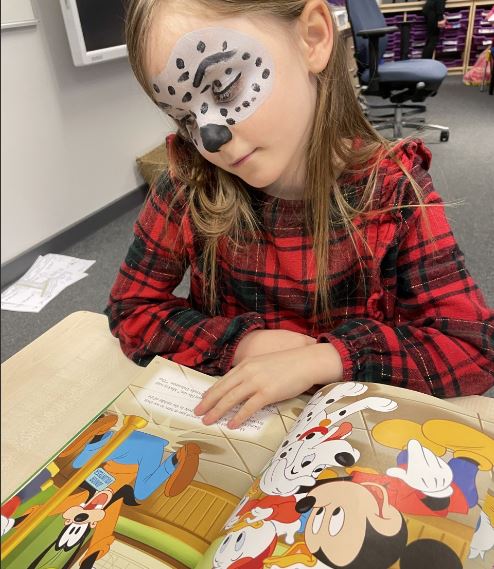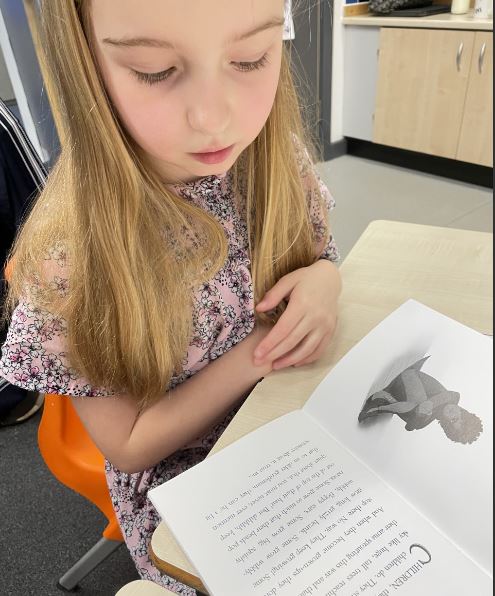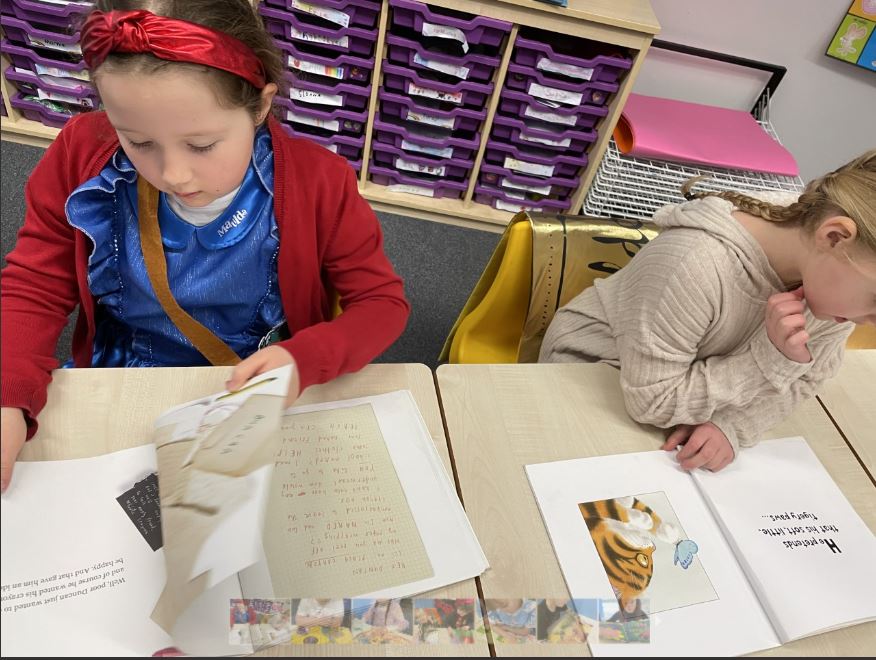Reading at Sandhill Primary
The Literacy Leader is Mrs N Baker
|
Our ultimate aim is to teach the children to read well, read with fluency and read with comprehension meaning they understand what they read whilst fostering a love of what it is they read.
It has astonishing benefits for children: comfort and reassurance, confidence and security, relaxation, happiness and fun. Giving a child time and full attention when reading them a story tells them they matter. It builds self-esteem, vocabulary, feeds imagination and even improves their sleeping patterns. |
|
Teaching reading is a responsibility we take very seriously and we are very committed to enabling all of our children to leave us as fluent, accurate and confident readers who read with purpose and enjoyment. We believe that reading is a critical skill which no child should be without and our approach ensures no child is left behind.
Throughout the school, we have a ‘phonics first’ approach to the teaching of reading and sustain our focus on the teaching of phonics from Early Years (Nursery and Reception pupils) through to Year 6. Children who can decode (sound out the words on the page) quickly and efficiently are able to read with expression and fluency - a priority focus for us in our Early Years and Key Stage 1, so that children are ready for their Key Stage 2 reading curriculum.
Throughout Key Stage 2, we continue to develop sophistication in reading fluency and deepen children’s understanding of a wide range of fiction, non-fiction and poetry. Our Key Stage 2 reading curriculum involves novel studies, enabling children to study a wide range of authors and genres in fiction, to use non-fiction texts to undertake their own research across the curriculum, and to enjoy poetry and performance.
Our mission is simple: to develop children who enjoy reading and who read a lot of books during their time with us, and well beyond.
Below is how we teach reading at Springwood and the progression of the skills that are needed for every child in our school to become a reader.
Throughout the school, we have a ‘phonics first’ approach to the teaching of reading and sustain our focus on the teaching of phonics from Early Years (Nursery and Reception pupils) through to Year 6. Children who can decode (sound out the words on the page) quickly and efficiently are able to read with expression and fluency - a priority focus for us in our Early Years and Key Stage 1, so that children are ready for their Key Stage 2 reading curriculum.
Throughout Key Stage 2, we continue to develop sophistication in reading fluency and deepen children’s understanding of a wide range of fiction, non-fiction and poetry. Our Key Stage 2 reading curriculum involves novel studies, enabling children to study a wide range of authors and genres in fiction, to use non-fiction texts to undertake their own research across the curriculum, and to enjoy poetry and performance.
Our mission is simple: to develop children who enjoy reading and who read a lot of books during their time with us, and well beyond.
Below is how we teach reading at Springwood and the progression of the skills that are needed for every child in our school to become a reader.
Your browser does not support viewing this document. Click here to download the document.
Reading at Home
Children love to get their head into a good book and this can be enhanced further through reading at home.
HOW TO HELP YOU CHILD READ AT HOME:
1. Choose a quiet time. Set aside a quiet time with no distractions. Ten to fifteen minutes is usually long enough.
2. Make reading an enjoyable experience. Sit with or near to your child. Try not to pressurise if he or she is reluctant or tired. It is often helpful to look together at the book first of all, commenting on the pictures and the title – as this will give support for successful reading of the book.
3. Maintain the flow. If your child mispronounces a word, do not interrupt immediately. Instead allow opportunity for self-correction. It is better to tell a child some unknown words first to maintain the flow, rather than insisting on trying to build them all up from the sounds of the letters. For children in the early stages of learning to read, it is helpful to encourage them to point at the words, as this supports them in tracking the words on the page.
4. Be positive. If your child says something nearly right to start with, that is fine. Don't say 'No. That's wrong,' but 'Let's read it together' – and then point to the words as you say them. Boost your child's confidence with constant praise for even the smallest achievement.
5. Success is the key. Remember 'Nothing succeeds like success'. Until your child has built up his or her confidence, it is better to keep to easier books. Struggling with a book with many unknown words is pointless. Flow is lost, text cannot be understood and children can easily become reluctant readers.
6. Regular practice. Try to read with your child on most school days. 'Little and often' is best. Teachers have limited time to hear children read individually. For older children it is ok if they are reading on their own throughout the week, but not every night. Try and set at least two nights aside that you can listen to your child.
7. Talk about the books There is more to being a good reader than just being able to read the words accurately. Just as important is being able to understand what has been read. Always talk to your child about the book; about the pictures, the characters, how they think the story will end, and their favourite part. You will then be able to see how well they have understood and you will help them to develop good comprehension skills. Some of the reading scheme books have suggestions, on the back page, for questions that could be asked.
8. Variety is important. Remember children need to experience a variety of reading materials. If possible, please give your child opportunity to experience this through a range of picture books, comics, magazines, poems, and information books. To help with this, your child will be bringing home a chosen book from school. Also, public libraries have a wide selection of story and information books, and bargain books can be found in charity shops.
9. Have a reading time together Is there some time (maybe even 15 minutes) at some point in the week, that you or another member of your family can read your own book in front of your child? By showing your child that you have an interest in reading will influence them as well.
Children love to get their head into a good book and this can be enhanced further through reading at home.
HOW TO HELP YOU CHILD READ AT HOME:
1. Choose a quiet time. Set aside a quiet time with no distractions. Ten to fifteen minutes is usually long enough.
2. Make reading an enjoyable experience. Sit with or near to your child. Try not to pressurise if he or she is reluctant or tired. It is often helpful to look together at the book first of all, commenting on the pictures and the title – as this will give support for successful reading of the book.
3. Maintain the flow. If your child mispronounces a word, do not interrupt immediately. Instead allow opportunity for self-correction. It is better to tell a child some unknown words first to maintain the flow, rather than insisting on trying to build them all up from the sounds of the letters. For children in the early stages of learning to read, it is helpful to encourage them to point at the words, as this supports them in tracking the words on the page.
4. Be positive. If your child says something nearly right to start with, that is fine. Don't say 'No. That's wrong,' but 'Let's read it together' – and then point to the words as you say them. Boost your child's confidence with constant praise for even the smallest achievement.
5. Success is the key. Remember 'Nothing succeeds like success'. Until your child has built up his or her confidence, it is better to keep to easier books. Struggling with a book with many unknown words is pointless. Flow is lost, text cannot be understood and children can easily become reluctant readers.
6. Regular practice. Try to read with your child on most school days. 'Little and often' is best. Teachers have limited time to hear children read individually. For older children it is ok if they are reading on their own throughout the week, but not every night. Try and set at least two nights aside that you can listen to your child.
7. Talk about the books There is more to being a good reader than just being able to read the words accurately. Just as important is being able to understand what has been read. Always talk to your child about the book; about the pictures, the characters, how they think the story will end, and their favourite part. You will then be able to see how well they have understood and you will help them to develop good comprehension skills. Some of the reading scheme books have suggestions, on the back page, for questions that could be asked.
8. Variety is important. Remember children need to experience a variety of reading materials. If possible, please give your child opportunity to experience this through a range of picture books, comics, magazines, poems, and information books. To help with this, your child will be bringing home a chosen book from school. Also, public libraries have a wide selection of story and information books, and bargain books can be found in charity shops.
9. Have a reading time together Is there some time (maybe even 15 minutes) at some point in the week, that you or another member of your family can read your own book in front of your child? By showing your child that you have an interest in reading will influence them as well.






